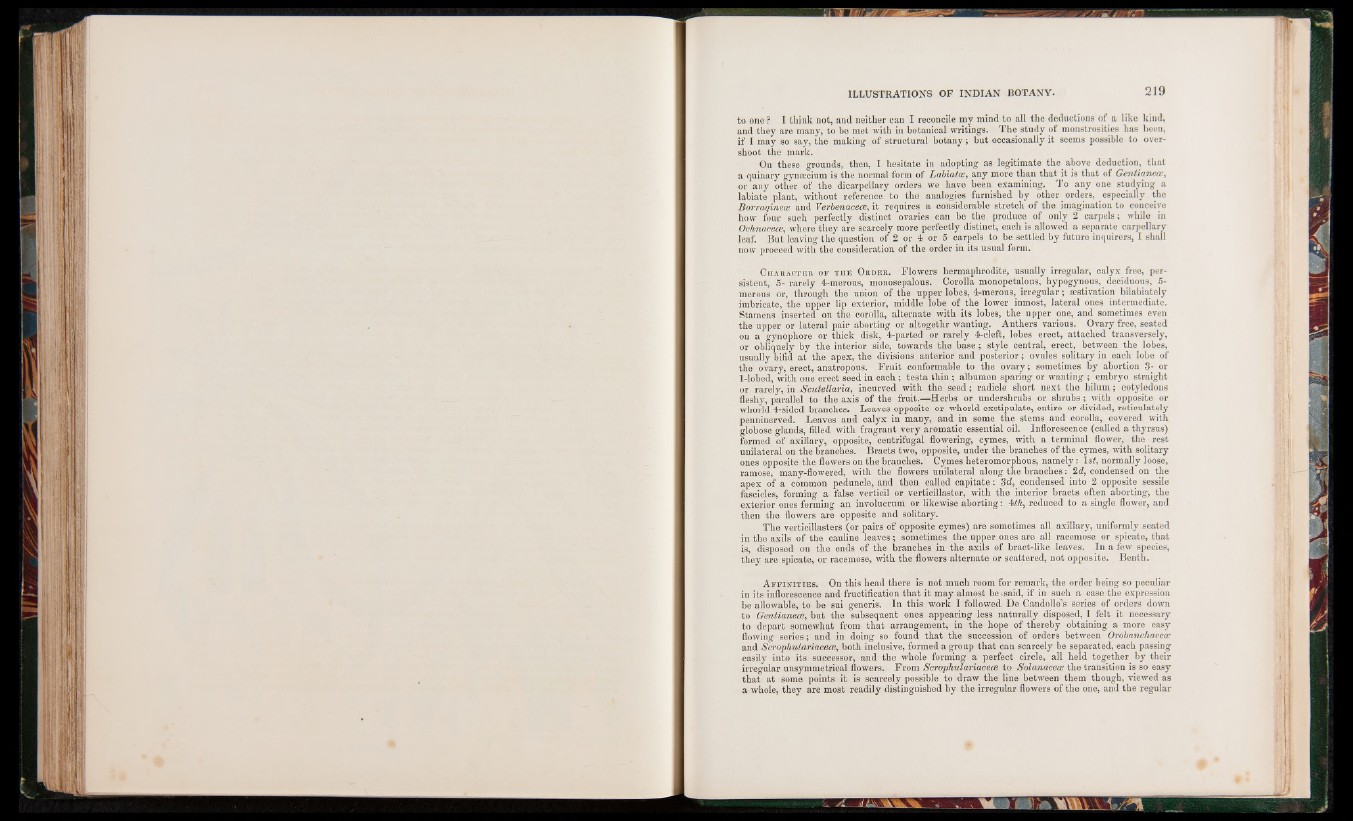
to one ? I think not, and neither can I reconcile my mind to all the deductions of^ a like kind,
and they are many, to be met with in botanical writings. The study of monstrosities has been,
if I may so say, the making of structural botany; but occasionally it seems possible to overshoot
the mark.
On these grounds, then, I hesitate in adopting as legitimate the above deduction, that
a quinary gynsecium is the normal form of Labiates, any more than that it is that of Gentianece,
or any other of the dicarpellary orders we have been examining. To any one studying a
labiate plant, without reference to the analogies furnished by other _ orders, especially the
Borraginece and Verbenacece, it requires a considerable stretch of the imagination to conceive
how four such perfectly distinct ovaries can be the produce of only 2 carpels; while in
Ochnacete, where they are scarcely more perfectly distinct, each is allowed a separate carpellary
leaf. But leaving the question of 2 or 4 or 5 carpels to be settfed by future inquirers, I shall
now proceed with the consideration of the order in its usual form.
C h a b a c t e e of t h e O b o e s . Flowers hermaphrodite, usually irregular, calyx free, persistent,
5- rarely 4-merous, monosepalous. Corolla monopetalous, hypogynous, deciduous, 5-
merous or, through the union of the upper lobes, 4-merous, irregular; aestivation bilabiately
imbricate, the upper lip exterior, middle lobe of the lower inmost, lateral ones intermediate.
Stamens inserted on the corolla, alternate with its lobes, the upper one, and sometimes even
the upper or lateral pair aborting or altogethr wanting. Anthers various. Ovary free, seated
on a gynophore or thick disk, 4-parted or rarely 4-cleft, lobes erect, attached transversely,
or obliquely by the interior side, towards the base; style central, erect, between the lobes,
usually bifid at the apex, the divisions anterior and posterior; ovules solitary in each lobe of
the ovary, erect, anatropous. Fruit conformable to the ovary; sometimes by abortion 3- or
1-lobed, with one erect seed in each; testa thin ; albumen sparing or wanting ; embryo straight
or rarely, in Scutellaria, incurved with the seed; radicle short next the hilum; cotyledons
fleshy, parallel to the axis of the fruit.—Herbs or undershrubs or shrubs; with opposite or
whorld 4-sided branches. Leaves opposite or whorld exstipulate, entire or divided, reticulately
penninerved. Leaves and calyx in many, and in some the stems and corolla, covered with
globose glands, filled with fragrant very aromatic essential oil. Inflorescence (called a thyrsus)
formed of axillary, opposite, centrifugal flowering, cymes, with a terminal flower, the rest
unilateral on the branches. Bracts two, opposite, under the branches of the cymes, with solitary
ones opposite the flowers on the branches. Cymes heteromorphous, namely; lstf, normally loose,
ramose, many-flowered, with the flowers unilateral along the branches: 2d, condensed on the
apex of a common peduncle, and then called capitate: 3d, condensed into 2 opposite sessile
fascicles, forming a false verticil or verticillaster, with the interior bracts often aborting, the
exterior ones forming an involucrum or likewise aborting: 4<th, reduced to a single flower, and
then the flowers are opposite and solitary.
The verticillasters (or pairs of opposite cymes) are sometimes all axillary, uniformly seated
in the axils of the cauline leaves; sometimes the upper ones are all racemose or spicate, that
is, disposed on the ends of the branches in the axils of bract-like leaves. In a few species,
they are spicate, or racemose, with the flowers alternate or scattered, not opposite. Benth.
A f f in i t i e s . On this head there is not much room for remark, the order being so peculiar
in its inflorescence and fructification that it may almost be tsaid, if in such a case the expression
be allowable, to be sui generis. In this work I followed De Candolle’s series of orders down
to Gentianece, but the subsequent ones appearing less naturally disposed, I felt it necessary
to depart somewhat from that arrangement, in the hope of thereby obtaining a more easy
flowing series; and in doing so found that the succession of orders between Orobanchacece
and Scrophulariacece, both inclusive, formed a group that can scarcely be separated, each passing
easily into its successor, and the whole forming a perfect circle, all held together by their
irregular unsymmetrical flowers. From Scrophulariacece to Solandcece the transition is so easy
that at some points it is scarcely possible to draw the line between them though, viewed as
a whole, they are most readily distinguished by the irregular flowers of the one, and the regular